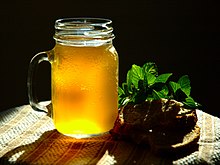Kvass

Kvass or kvass (obsolete also kvass ; Russian квас ) is a drink from the ostslawisch- and partly südslawischsprachigen space obtained by fermentation is made from bread. Today, kvass is mainly found in Russia , Belarus , Ukraine , Serbia , Montenegro and the Baltic States . The drink but now a certain notoriety in other countries in Europe and the Caucasus reached. Although mostly of bread or biscuits produced and therefore the term bread drink or bread drink (registered trademark) is known, there are other formulations, such as kvass from pears, berries or other fruits.
etymology
The word kvass was first mentioned in a document in 989 and means something like “sour drink” or “fermented”, as kvass has a slightly sour taste. Etymologically, it comes from the same Indo-European root as the German word cheese . The Russian verb "kwasit '" (квасить) means "to sour", "to sour".
properties
The color and taste of kvass are comparable to malt beer , but kvass is not as sweet. It has a slight lemon taste that is reminiscent of shandy . The smell is reminiscent of fresh bread. When pouring it forms a head of foam. Kvass usually contains 0.05–1.2 percent alcohol and, due to lactic acid bacteria , has a digestive effect. The lactic acid content is around 0.18–0.48 percent.
distribution
Kvass is sold on the streets in many parts of Russia and Ukraine during the summer from tank trucks painted in yellow with Квас written on it . Industrially produced kvass in plastic bottles is widespread in Russia. Half-liter cans are available for export. In 2007, 860 million liters of kvass were consumed in Russia.
The drink is also known in Poland , the Baltic States and the Caucasus, in Lithuania under the name (Duonos) Gira , in Latvia as Kvass , in Estonia under Kali and in Georgia the drink is called Burachi (ბურახი). In Germany, kvass is sometimes called bread beer , but it should be noted that in Russian bread beer (хлебное пиво) denotes beer and not kvass. In the GDR , kvass was produced in some breweries, preferably by the Diamant brewery in Magdeburg . In the old Federal Republic of Germany , Isenbeck made an elaborate attempt at the end of the 1960s to establish kvass on the market.
Manufacturing
Basically you need old bread or malt , rye flour (at home also rye bread ) and kvass yeast or sourdough to make kvass . To increase the carbonic acid content , you can also add sugar or molasses . Depending on the type of kvass, flavorings such as mint , currant , raisins etc. are also used. v. m. used in the creation. In house production, improper management of the fermentation process can easily lead to incorrect fermentation.
There are instant powder and liquid kvass concentrates for making kvass, which are mixed with water and yeast may be added. In Germany, such preliminary products - as well as finished kvass in bottles - can be purchased in shops that sell Russian products.
Web links
- Further information from brotbier.de
- Kvass recipe from russlandjournal.de
- Jennifer Jeremejewa: Kvass: Russia's true national drink. In: Russia Beyond the Headlines . July 21, 2012, accessed June 10, 2018 .
Individual evidence
- ↑ https://www.duden.de/rechtschreibung/Kwass
- ↑ QUAS, quasz. In: Jacob Grimm , Wilhelm Grimm (Hrsg.): German dictionary . tape 13 : N, O, P, Q - (VII). S. Hirzel, Leipzig 1889 ( woerterbuchnetz.de ).
- ↑ Julia Schoon: Delicacies worldwide: 99 specialties that you should (better not) try . neobooks, 2013, ISBN 978-3-7427-4254-4 ( google.de [accessed on July 17, 2018]).
- ↑ Register information from the German Patent and Trademark Office (DPMA)
- ↑ Manfred Quiring : Drinking Ur-Russian . In: The world . May 2, 2008, p. 1 ( welt.de ).
- ↑ Trade / Drinks: Having fun with kvass . In: Der Spiegel . No. 14 , 1969 ( online ).


